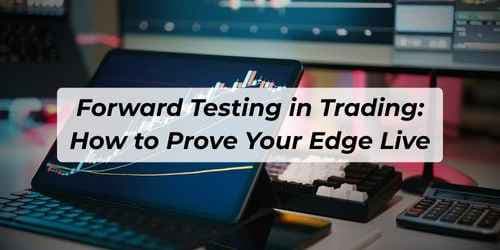
Forward Testing in Trading: How to Prove Your Edge Live
 ACY Securities - Japer Osita
ACY Securities - Japer OsitaEvery trading edge looks sharp on paper. Backtesting shows what could have worked, spreadsheets confirm the numbers, and your system feels bulletproof in theory. But the real test doesn’t happen in hindsight - it happens when you put that edge in the wild. This stage is called forward testing, and it’s where many traders either refine their strategy into something durable or abandon it prematurely out of frustration. If you’ve been building structure with multi-timeframe confluence, the same way we do in The Power of Multi-Timeframe Analysis in SMC, forward testing is the proof that your planning can survive real execution.

Forward testing bridges the gap between theory and reality, giving you the confidence that your edge survives the unpredictability of live markets. It’s the step after you prove your edge without bias in backtesting, where you stress-test not just the setup but your ability to execute it under pressure.
Demo vs Live Forward Testing

When you first bring your strategy out of the lab, there are two main ways to test it: demo accounts and live accounts.
Demo Forward Testing. Demo accounts give you a safe environment to execute trades without financial risk; use this phase to iron out mechanics - chart markup, order placement, partials, and management - for example, practice your moving average playbook routines or rehearse how you’ll place targets based on Fibonacci extensions for stops and TPs. This is the “training wheels” stage - useful, but incomplete.
Live Forward Testing. At some point, demo stops teaching you. Real markets trigger emotions that no demo can simulate. A tiny position - $1 risk or micro-lots - exposes you to the pressure of money on the line. That’s where you learn whether your routine, like How to Trade & Scalp Indices at the Open using SMC, holds up when spreads widen, slippage appears, or your heart rate climbs into a breakout.
The smartest traders start in demo, then transition to live quickly with tiny size - just enough to feel the heat, not enough to burn the account.
Backtesting vs Forward Testing: Strategy vs Emotions
Backtesting and forward testing share the same backbone - you’re testing a framework or strategy against the markets. In backtesting, the trial is clinical. You’re running the rules against historical data, checking probabilities, and validating structure. If your framework centers on liquidity and displacement, revisit Fair Value Gaps Explained and Understanding Liquidity Sweep while you measure it.
Forward testing adds two new variables: your emotions and your mental capital. You’re no longer just testing if the framework works - you’re testing if you can work the framework under pressure. Backtesting asks, Does this edge make sense mathematically? Forward testing asks, Can I execute this edge faithfully when fear, greed, and doubt enter the room? That’s why many strategies that look bulletproof on paper fall apart live: the system didn’t fail - the trader did. If you need a mental model, skim How to Think Like a Price Action Trader to re-anchor your mindset before stepping in.
The Discipline Challenge
Forward testing isn’t about proving your strategy is flawless - it’s about proving you can execute it when it matters.
- Your edge might win long-term, but you’ll still face strings of losses.
- You’ll second-guess entries that looked perfect on paper but feel shaky live.
- You’ll be tempted to “tweak” rules after two losses, forgetting that probability needs time to play out.
This is the emotional crucible of forward testing: staying disciplined when the edge is supposed to work but hasn’t paid off yet. That’s where most traders fail - they quit too soon, or they modify rules mid-test and destroy the integrity of the process. To keep yourself grounded, revisit Mastering Risk Management: SL/TP/Position Sizing and the Ultimate Risk Management Compilation; the right risk plan shrinks the urge to meddle mid-trade.
Forward testing is less about the market and more about you - your identity, habits, and rules. If you need to tighten your behavioral edge, Identity-Based Trading and Discipline vs. Impulse will help you show up like the trader your plan requires.
Real-Life Analogy: A Chef in the Real Kitchen

Think of a chef. In the lab, they design recipes with precision: measuring ingredients, testing flavors, and refining dishes in a controlled space. Everything looks perfect under lab conditions.
But the true test happens in a real restaurant kitchen. The heat is higher, the clock is ticking, and orders keep flying. A dish that worked in the lab might fall apart unless the chef can stay composed, sequence steps, and plate on time. Trading is the same. Backtesting is your lab. Forward testing is your kitchen - where you learn whether your edge not only works, but whether you can deliver it when the heat is on. If you like “sequenced execution,” train entries the way you would a setup retest with confirmation, as shown in Mastering Retests.
Why Forward Testing Fails for Most Traders
If forward testing is so essential, why do most traders fail at it? Because they treat it like backtesting 2.0 instead of an emotional trial.
- 1. Quitting Too Soon. Many stop after 5–10 trades because the curve isn’t pretty. Commit to 50–100 trades; even strong edges suffer losing streaks. If you doubt this, study the math behind survival in Risk of Ruin.
- 2. Changing Rules Mid-Test. Tweaking entries, widening stops, or cutting profits early invalidates the test. When you see a clean shift at the open, lean on a pre-defined routine like How To Trade & Scalp Indices at the Open using SMC rather than improvising under stress.
- 3. Over-Risking Out of Impatience. Jumping to full size to “prove the edge” quickly invites impulsive errors and spirals into revenge trading; if stop hunts rattle you, read How to Lessen Risk From Stop Hunts and Stop Hunting 101 to reframe liquidity pockets as part of the plan.
- 4. Focusing Only on Results, Not Execution. A losing streak can be a “pass” if you executed flawlessly; a green P/L can be a “fail” if you broke rules. To sharpen the eye, revisit Mastering Price Action at Key Levels so your grading includes process quality.
Think of forward testing less like proving your edge to others, and more like proving your discipline to yourself. That mindset shift separates professionals from hobbyists. When headlines add fuel, keep the structure of CPI and NFP SMC gameplans and How to Trade NFP Using SMC close; news doesn’t invalidate rules - it stress-tests them.
How to Forward Test Like a Pro
- 1. Start Small. Use micro-lots or minimal risk to simulate real execution without emotional overload. If you trade Gold, pair tiny size with structure like RSI Divergence for trend reversals or the Gold Stochastics 2R–3R approach.
- 2. Set a Fixed Sample Size. Commit to 20, 50, or 100 trades before judging performance. This protects you from narrative swings. If you’re building a day-trading routine, align with 3 Steps to Build a Day-Trading Routine so the sample happens inside a consistent daily flow.
- 3. Keep a Forward-Testing Journal. Track wins/losses and emotions, rule adherence, and execution quality. When frustration spikes, reset with Mastering Frustration: Turning Losses into Lessons and tighten risk per How Much Should You Risk per Trade?
- 4. Treat Demo as Mechanics, Live as Discipline. Use demo to automate tasks (bracket orders, alerts, partials), then flip to live for emotional reps. When markets rotate between risk-on/off regimes, keep your playbook anchored with How to Identify and Trade Risk-On/Risk-Off.
- 5. Review With Context. After your sample, compare results to backtests: were losses variance or rule-breaks? If your entries were “late,” study Mastering Candlestick Pattern Analysis with SMC and Engulfing/Retest guides to refine confirmation.
Final Thoughts

Forward testing is the trader’s proving ground. It strips away the comfort of hindsight and shows you what really matters - your ability to stay consistent under pressure. A strategy that works in backtests may stumble live, not because it’s broken, but because you couldn’t deliver it faithfully. Treat this stage as both a test of your edge and a test of yourself.
This week’s challenge: trade your plan live with the smallest size, commit to a 20–50 trade sample, and journal three things per position: (1) rule adherence, (2) execution timing, (3) dominant emotion. If the routine wobbles, recalibrate with Trading Journal & Reflection – The Trader’s Mirror and re-run the sample. By the end, you’ll know whether your edge holds - and more importantly, whether you do.
Start Practicing with Confidence - Risk-Free!
- Trade forex, indices, gold, and more
- Access ACY, MT4, MT5, & Copy Trading Platforms
- Practice with zero risk
It’s time to go from theory to execution - risk-free.
Create an Account. Start Your Free Demo!
Check Out My Contents:
Strategies That You Can Use
Looking for step-by-step approaches you can plug straight into the charts? Start here:
- How To Trade & Scalp Indices at the Open Using Smart Money Concepts (SMC)
- How to Trade Breakouts Effectively in Day Trading with Smart Money Concepts
- Complete Step-by-Step Guide to Day Trading Gold (XAU/USD) with Smart Money Concepts (SMC)
- The Power of Multi-Timeframe Analysis in Smart Money Concepts (SMC)
- Forex Trading Strategy for Beginners
- Mastering Candlestick Pattern Analysis with the SMC Strategy for Day Trading
- How to Use Fibonacci to Set Targets & Stops (Complete Guide)
- RSI Divergence Trading Strategy for Gold: How to Identify and Trade Trend Reversals
- Stochastics Trading Secrets: How to Time Entries in Trending Markets using Stochastics
- Gold Trading Stochastics Strategy: How to Trade Gold with 2R - 3R Targets
- RSI Hidden Divergence Explained: How to Spot Trend Continuations Like a Pro
- Moving Averages Trading Strategy Playbook
- Mastering Fibonacci Trading Psychology - Trusting the Levels, Managing the Mind
- Mastering Price Action at Key Levels - How to Spot, Trade, and Win at the Most Crucial Zones
- Mastering Retests: How to Enter with Confirmation After a Breakout
Indicators / Tools for Trading
Sharpen your edge with proven tools and frameworks:
- The Ultimate Guide to Risk Management in Trading - A Complete Compilation for 2025
- Moving Averages Trading Strategy Playbook
- How to Think Like a Price Action Trader
- Mastering Fibonacci Trading Psychology - Trusting the Levels, Managing the Mind
How To Trade News
News moves markets fast. Learn how to keep pace with SMC-based playbooks:
- Why Smart Money Concepts Work in News-Driven Markets - CPI, NFP, and More
- How to Trade NFP Using Smart Money Concepts (SMC)-A Proven Strategy for Forex Traders
- How to Trade CPI Like Smart Money - A Step-by-Step Guide Using SMC
Learn How to Trade US Indices
From NASDAQ opens to DAX trends, here’s how to approach indices like a pro:
- How to Start Trading Indices and Get into the Stock Market with Low Capital (2025 Guide)
- Best Indices to Trade for Day Traders | NASDAQ, S&P 500, DAX + Best Times to Trade Them
- How To Trade & Scalp Indices at the Open Using Smart Money Concepts (SMC)
- NAS100 - How to Trade the Nasdaq Like a Pro (Smart Money Edition)
How to Start Trading Gold
Gold remains one of the most traded assets - - here’s how to approach it with confidence:
- How to Swing Trade Gold (XAU/USD) Using Smart Money Concepts: A Simple Guide for Traders
- Complete Step-by-Step Guide to Day Trading Gold (XAU/USD) with Smart Money Concepts (SMC)
- The Ultimate Guide to Backtesting and Trading Gold (XAU/USD) Using Smart Money Concepts (SMC)
- Why Gold Remains the Ultimate Security in a Shifting World
- How to Exit & Take Profits in Trading Gold Like a Pro: Using RSI, Range Breakdowns, and MAs as Your Confluence
How to Trade Japanese Candlesticks
Candlesticks are the building blocks of price action. Master the most powerful ones:
- Mastering the Top Japanese Candlesticks: The Top 5 Candlesticks To Trade + Top SMC Candlestick Pattern
- How to Trade Candlestick Patterns with High Probability: A Complete Guide for Beginners
- The Top Japanese Candlestick Guide: What is an Engulfing Pattern and How to Trade It?
- Piercing Pattern Candlestick Explained: How to Trade It - Step-By-Step Guide
- Morning & Evening Star Candlestick Patterns - How to Trade Market Reversals with Confidence
How to Start Day Trading
Ready to go intraday? Here’s how to build consistency step by step:
- 5 Steps to Start Day Trading: A Strategic Guide for Beginners
- 8 Steps How to Start Forex Day Trading in 2025: A Beginner’s Step-by-Step Guide
- 3 Steps to Build a Trading Routine for Consistency and Discipline - Day Trading Edition
- The Ultimate Guide to Understanding Market Trends and Price Action
- Trading with Momentum: The Best Trading Session to Trade Forex, Gold and Indices
Learn how to navigate yourself in times of turmoil
Markets swing between calm and chaos. Learn to read risk-on vs risk-off like a pro:
- How to Identify Risk-On and Risk-Off Market Sentiment: A Complete Trader’s Guide
- How to Trade Risk-On and Risk-Off Sentiment - With Technical Confirmation
- The Ultimate Guide to Understanding Market Trends and Price Action
Want to learn how to trade like the Smart Money?
Step inside the playbook of institutional traders with SMC concepts explained:
- Why Smart Money Concepts Work: The Truth Behind Liquidity and Price Action
- Mastering the Market with Smart Money Concepts: 5 Strategic Approaches
- Understanding Liquidity Sweep: How Smart Money Trades Liquidity Zones in Forex, Gold, US Indices
- The SMC Playbook Series Part 1: What Moves the Markets? Key Drivers Behind Forex, Gold & Stock Indices
- The SMC Playbook Series Part 2: How to Spot Liquidity Pools in Trading-Internal vs External Liquidity Explained
- Fair Value Gaps Explained: How Smart Money Leaves Footprints in the Market
- Accumulation, Manipulation, Distribution: The Hidden Cycle That Runs Every Market
- Institutional Order Flow - Reading the Market Through the Eyes of the Big Players
- London Session Trading Secrets: How Smart Money Sets the High & Low of the Day
- Mastering the New York Session - Smart Money Concepts Guide
Master the World’s Most Popular Forex Pairs
Forex pairs aren’t created equal - - some are stable, some are volatile, others tied to commodities or sessions.
- The Top 5 All-Time Best Forex Pairs to Trade
- Top Forex Pairs Beyond the Big Five
- EUR/USD: The King of Forex
- USD/JPY: The Fast Mover
- GBP/USD: The Volatile Cable
- AUD/USD: The Commodity Currency
- USD/CAD: The Oil-Backed Pair
- GBP/JPY: How to Trade The Beast
- Asian & London Session Secrets
- Mastering the New York Session
Stop Hunting 101
If you’ve ever been stopped out right before the market reverses - - this is why:
- Stop Hunting 101: How Swing Highs and Lows Become Liquidity Traps
- Outsmarting Stop Hunts: The Psychology Behind the Trap
- How to Lessen Risk From Stop Hunts in Trading
- How Stop Hunts Trigger Revenge Trading - Breaking the Pain Cycle
- How to Accept Stop Hunts Without Losing Discipline - Shifting From Frustration to Focus
Trading Psychology
Mindset is the deciding factor between growth and blowups. Explore these essentials:
- The Mental Game of Execution - Debunking the Common Trading Psychology
- Managing Trading Losses: Why You Can Be Wrong and Still Win Big in Trading
- The Hidden Threat in Trading: How Performance Anxiety Sabotages Your Edge
- Why 90% of Retail Traders Fail Even with Profitable Trading Strategies
- Top 10 Habits Profitable Traders Follow Daily to Stay Consistent
- Top 10 Trading Rules of the Most Successful Traders
- Top 10 Ways to Prevent Emotional Trading and Stay Disciplined in the Markets
- Why Most Traders Fail - Trading Psychology & The Hidden Mental Game
- Emotional Awareness in Trading - Naming Your Triggers
- Discipline vs. Impulse in Trading - Step-by Step Guide How to Build Control
- Trading Journal & Reflection - The Trader’s Mirror
- Overcoming FOMO & Revenge Trading in Forex - Why Patience Pays
- Risk of Ruin in Trading - Respect the Math of Survival
- Identity-Based Trading: Become Your Trading System for Consistency
- Trading Psychology: Aligning Emotions with Your System
- Mastering Fear in Trading: Turn Doubt into a Protective Signal
- Mastering Greed in Trading: Turn Ambition into Controlled Growth
- Mastering Boredom in Trading: From Restless Clicking to Patient Precision
- Mastering Doubt in Trading: Building Confidence Through Backtesting and Pattern Recognition
- Mastering Impatience in Trading: Turn Patience Into Profit
- Mastering Frustration in Trading: Turning Losses Into Lessons
- Mastering Hope in Trading: Replacing Denial With Discipline
- When to Quit on Trading - Read This!
- The Math of Compounding in Trading
- Why Daily Wins Matter More Than Big Wins
- Scaling in Trading: When & How to Increase Lot Sizes
- Why Patience in Trading Fuels the Compounding Growth
- Step-by-Step Guide on How to Manage Losses for Compounding Growth
- The Daily Habits of Profitable Traders: Building Your Compounding Routine
- Trading Edge: Definition, Misconceptions & Casino Analogy
- Finding Your Edge: From Chaos to Clarity
- Proving Your Edge: Backtesting Without Bias
Risk Management
The real edge in trading isn’t strategy - it’s how you protect your capital:
- Mastering Risk Management: Stop Loss, Take Profit, and Position Sizing
- Why Risk Management Is the Only Edge That Lasts
- How Much Should You Risk per Trade? (1%, 2%, or Less?)
- The Ultimate Risk Management Plan for Prop Firm Traders - Updated 2025
- Mastering Position Sizing: Automate or Calculate Your Risk Like a Pro
- Martingale Strategy in Trading: Compounding Power or Double-Edged Sword?
- How to Add to Winners Using Cost Averaging and Martingale Principle with Price Confirmation
Suggested Learning Path
If you’re not sure where to start, follow this roadmap:
- 1. Start with Trading Psychology → Build the mindset first.
- 2. Move into Risk Management → Learn how to protect capital.
- 3. Explore Strategies & Tools → Candlesticks, Fibonacci, MAs, Indicators.
- 4. Apply to Assets → Gold, Indices, Forex sessions.
- 5. Advance to Smart Money Concepts (SMC) → Learn how institutions trade.
- 6. Specialize → Stop Hunts, News Trading, Turmoil Navigation.
This way, you’ll grow from foundation → application → mastery, instead of jumping around randomly.
Follow me for more daily market insights!
Jasper Osita - LinkedIn - FXStreet - YouTube
This content may have been written by a third party. ACY makes no representation or warranty and assumes no liability as to the accuracy or completeness of the information provided, nor any loss arising from any investment based on a recommendation, forecast or other information supplies by any third-party. This content is information only, and does not constitute financial, investment or other advice on which you can rely.
LiquidityFinder
LiquidityFinder was created to take the friction out of the process of sourcing Business to Business (B2B) liquidity; to become the central reference point for liquidity in OTC electronic markets, and the means to access them. Our mission is to provide streamlined modern solutions and share valuable insight and knowledge that benefit our users.
If you would like to contribute to our website or wish to contact us, please click here or you can email us directly at press@liquidityfinder.com.
